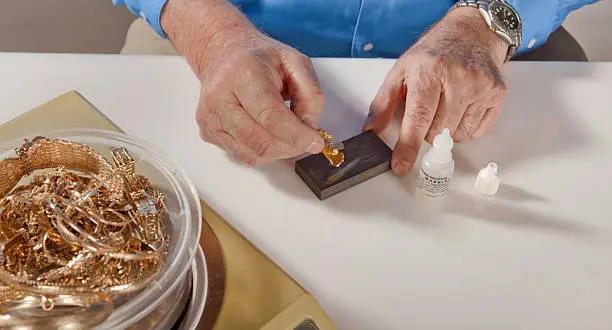Gold is a valuable metal, but with so many fake or mixed metals on the market, it’s important to know if what you have is real. Whether you’re buying, selling, or simply curious about a piece of gold jewelry or coin, there are several ways to test its authenticity. Here’s how to test gold at home and with professional methods.
- Check for Hallmarks
Many real gold pieces have a stamp or hallmark indicating their purity.
- Look for a small engraving with numbers like 10K, 14K, 18K, or 24K, which represent the gold’s karat level.
- Some jewelry may have “GP” (gold plated) or “GF” (gold filled), meaning it’s not solid gold.
- Over time, fake hallmarks may wear off, so this test alone isn’t always reliable.
- Perform a Magnet Test
Gold is not magnetic, so a simple magnet test can help check authenticity.
- Use a strong magnet (like a neodymium magnet) and bring it close to the gold item.
- If the gold piece sticks to the magnet, it likely contains other metals and is not pure gold.
- If it doesn’t stick, it may be real gold, but further testing is needed.
- Use the Ceramic Scratch Test
Gold is soft and leaves a distinctive mark when scratched on an unglazed ceramic surface.
- Take a white, unglazed ceramic plate and gently rub the gold item on it.
- If it leaves a gold streak, it is likely real.
- If it leaves a black or grey streak, the item is likely fake or plated.
- Try the Vinegar Test
Gold does not react with vinegar, making it a simple home test.
- Place the gold item in a small container.
- Pour white vinegar over it and wait for a few minutes.
- If the gold changes color, it’s fake. If it remains unchanged, it’s likely real.
- Use the Nitric Acid Test (Caution Required)
This is a more advanced test that requires caution.
- Wear gloves and place the gold item on a stainless steel surface.
- Apply a small drop of nitric acid to the gold.
- If it turns green, the item contains other metals. If it turns milky white, it’s gold-plated silver. If it has no reaction, it’s likely real gold.
- Conduct a Float Test
Gold is dense and should sink in water.
- Fill a glass with water and drop the gold item inside.
- If it sinks immediately, it could be real. If it floats or sinks slowly, it may be fake or mixed with other metals.
- Professional Gold Testing Methods
If you’re still unsure, consider professional testing:
- Electronic gold testers use conductivity to check purity.
- X-ray fluorescence (XRF) machines analyze the metal content.
- Fire assay testing, done by professionals, is the most accurate method for determining gold purity.
Also Read: How To Take Care Of Your Vagina After Giving Birth
Email your news TIPS to Editor@Kahawatungu.com — this is our only official communication channel


